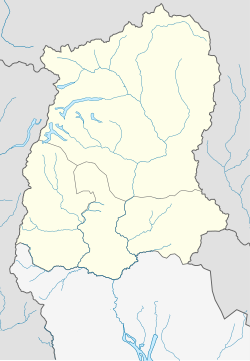Pemayangtse Monastery
| Pemayangtse Monastery | |
|---|---|

Main Shrine of Pemangytse Monastery
|
|
|
|
|
| Coordinates | 27°18′16″N 88°15′10″E / 27.30444°N 88.25278°ECoordinates: 27°18′16″N 88°15′10″E / 27.30444°N 88.25278°E |
| Monastery information | |
| Location | Pemayangtse, Sikkim, India |
| Founded by | Lama Lhatsun Chempo |
| Founded | 1705 |
| Type | Tibetan Buddhist |
| Number of monks | 108 |
| Festivals | Chaam, 28 -29th of the 12th Tibetan month. |
| Nearest town is Pelling | |
The Pemayangtse Monastery is a Buddhist monastery in Pemayangtse, near Pelling in the northeastern Indian state of Sikkim, located 140 kilometres (87 mi) west of Gangtok. Planned, designed and founded by Lama Lhatsun Chempo in 1705, it is one of the oldest and premier monasteries of Sikkim, also the most famous in west Sikkim. Originally built by Lhatsun Chenpo in the 17th century, as a small Lhakhang, it was subsequently enlarged during the reign of the third Chogyal Chakdor Namgyal who was considered as Lhatsun Chenpo's third reincarnate, Jigme Pawo. The monastery follows the Nyingma Order of Tibet Buddhism and controls all other monasteries of that Order in Sikkim. The monks of this monastery are normally chosen from the Bhutias of Sikkim.
The monastery was built for "pure monks" (ta-tshang) meaning "monks of pure Tibetan lineage", celibate and without any physical abnormality. This practice is still retained. Only the monks of Pemayangtse Monastery are entitled to the title "ta-tshang". The head lama of this monastery had the unique privilege of anointing the Chogyals of the erstwhile monarchy of Sikkim with holy water. Pemayangtse means "Perfect Sublime Lotus", and is said to represent one of the four plexus of the human body.
The Pemayangtse Monastery is part of Buddhist religious pilgrimage circuit starting with the first monastery at Yuksom known as the Dubdi Monastery, followed by Norbugang Chorten, Tashiding Monastery, the Rabdentse ruins, the Sanga Choeling Monastery, and the Khecheopalri Lake.
The history of the monastery is very closely linked to the reign of Chodar Namgyal at Rabdentse. Chador, a very religious person, had taken several initiatives to the spread of Buddhist religion in Sikkim. He had decreed that the second of every three sons of Bhutia family shall be ordained a monk of the Pemayangtse Monastery. During his reign, the Guru Lhakhang Tashiding (1715) was built. He not only patronized Buddhist religious places but also introduced the religious dances (mystery plays) to highlight the martial and native traditions of Sikkim.
...
Wikipedia

